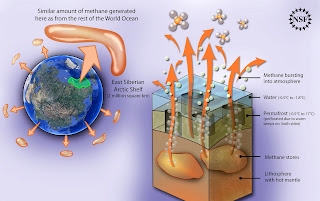A section of the Arctic Ocean seafloor that holds vast stores of frozen methane is showing signs of instability and widespread venting of the powerful greenhouse gas, according to the findings of an international research team led by University of Alaska Fairbanks scientists Natalia Shakhova and Igor Semiletov.
The research results, published in the March 5 edition of the journal Science, show that the permafrost under the East Siberian Arctic Shelf, long thought to be an impermeable barrier sealing in methane, is perforated and is starting to leak large amounts of methane into the atmosphere. Release of even a fraction of the methane stored in the shelf could trigger abrupt climate warming.
"The amount of methane currently coming out of the East Siberian Arctic Shelf is comparable to the amount coming out of the entire world's oceans," said Shakhova, a researcher at UAF's International Arctic Research Center. "Subsea permafrost is losing its ability to be an impermeable cap."
Methane is a greenhouse gas more than 30 times more potent than carbon dioxide. It is released from previously frozen soils in two ways. When the organic material (which contains carbon) stored in permafrost thaws, it begins to decompose and, under anaerobic conditions, gradually releases methane. Methane can also be stored in the seabed as methane gas or methane hydrates and then released as subsea permafrost thaws. These releases can be larger and more abrupt than those that result from decomposition.
The East Siberian Arctic Shelf is a methane-rich area that encompasses more than 2 million square kilometers of seafloor in the Arctic Ocean. It is more than three times as large as the nearby Siberian wetlands, which have been considered the primary Northern Hemisphere source of atmospheric methane. Shakhova's research results show that the East Siberian Arctic Shelf is already a significant methane source, releasing 7 teragrams of methane yearly, which is as much as is emitted from the rest of the ocean. A teragram is equal to about 1.1 million tons.
"Our concern is that the subsea permafrost has been showing signs of destabilization already," she said. "If it further destabilizes, the methane emissions may not be teragrams, it would be significantly larger."
Shakhova notes that the Earth's geological record indicates that atmospheric methane concentrations have varied between about .3 to .4 parts per million during cold periods to .6 to .7 parts per million during warm periods. Current average methane concentrations in the Arctic average about 1.85 parts per million, the highest in 400,000 years, she said. Concentrations above the East Siberian Arctic Shelf are even higher.
Notes Toward a Better Understanding of Six Intersecting Pieces of the Energy Puzzle: Climate Change, Peak Resources, Nuclear Proliferation, Food Security, Speculative Finance, and Geopolitics
January 13, 2011
Methane Leakage from Arctic Shelf
From the National Science Foundation, March 4, 2010, "Methane Releases From Arctic Shelf May be Much Larger and Faster Than Anticipated"

No comments:
Post a Comment